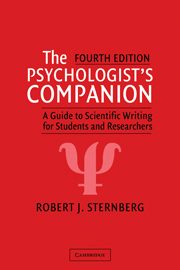Book contents
- Frontmatter
- Contents
- Acknowledgments
- Introduction
- 1 Eight Common Misconceptions about Psychology Papers
- 2 Steps in Writing the Library Research Paper
- 3 Steps in Writing the Experimental Research Paper
- 4 Rules for Writing the Psychology Paper
- 5 Using the Internet to Aid the Research Process
- 6 Commonly Misused Words
- 7 American Psychological Association Guidelines for Psychology Papers
- 8 Guidelines for Data Presentation
- 9 References for the Psychology Paper
- 10 Standards for Evaluating the Psychology Paper
- 11 Submitting a Paper to a Journal
- 12 How to Win Acceptances from Psychology Journals: Twenty-Nine Tips for Better Writing
- 13 Writing a Grant or Contract Proposal
- 14 How to Find a Book Publisher
- 15 Writing a Lecture
- 16 Article Writing 101
- References
- Appendix A Sample Psychology Paper
- Appendix B Writing for British and European Journals
- Index
8 - Guidelines for Data Presentation
Published online by Cambridge University Press: 05 June 2012
- Frontmatter
- Contents
- Acknowledgments
- Introduction
- 1 Eight Common Misconceptions about Psychology Papers
- 2 Steps in Writing the Library Research Paper
- 3 Steps in Writing the Experimental Research Paper
- 4 Rules for Writing the Psychology Paper
- 5 Using the Internet to Aid the Research Process
- 6 Commonly Misused Words
- 7 American Psychological Association Guidelines for Psychology Papers
- 8 Guidelines for Data Presentation
- 9 References for the Psychology Paper
- 10 Standards for Evaluating the Psychology Paper
- 11 Submitting a Paper to a Journal
- 12 How to Win Acceptances from Psychology Journals: Twenty-Nine Tips for Better Writing
- 13 Writing a Grant or Contract Proposal
- 14 How to Find a Book Publisher
- 15 Writing a Lecture
- 16 Article Writing 101
- References
- Appendix A Sample Psychology Paper
- Appendix B Writing for British and European Journals
- Index
Summary
This chapter draws heavily on three sources to which readers are referred for more details. For the presentation of data in the form of tables, Andrew Ehrenberg's Data Reduction and A Primer in Data Reduction contain much good sound advice. For the use of figures, William Cleveland's The Elements of Graphing Data is a style guide that is required reading for anyone considering using a graph, from the most junior undergraduate to the most experienced researcher. Good advice is also available in Tufte (1983) and Wainer (1984).
Tables and figures allow large amounts of material to be presented concisely. Well presented, they often enable a reader to understand at a glance patterns of data and exceptions that would be obscured if presented in the text. Tables and figures are expensive for journals to produce, however, so if you plan to submit a paper for publication, you should present in this form only your most important sets of data. Do not duplicate data from one table or figure to another unless it is essential for comprehension. Extensive sets of data should be reported in appendixes rather than in the body of the paper.
The same principles apply to the effective presentation of tables and figures as apply to effective scientific writing. The basic rule is to aim for simple, direct presentation, with no unnecessary clutter.
- Type
- Chapter
- Information
- The Psychologist's CompanionA Guide to Scientific Writing for Students and Researchers, pp. 142 - 164Publisher: Cambridge University PressPrint publication year: 2003



